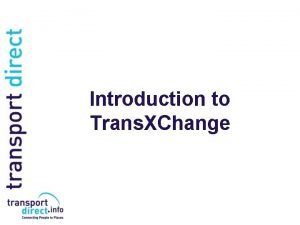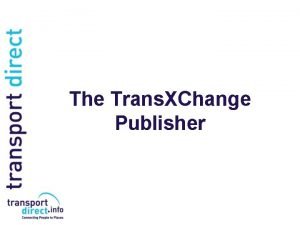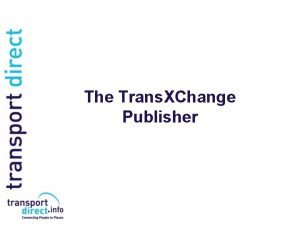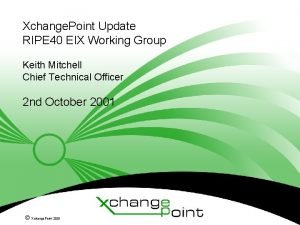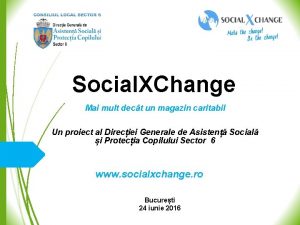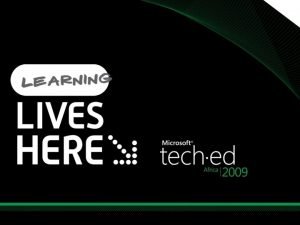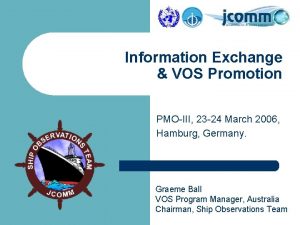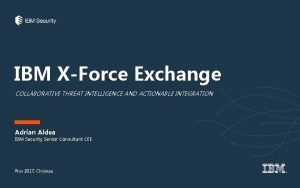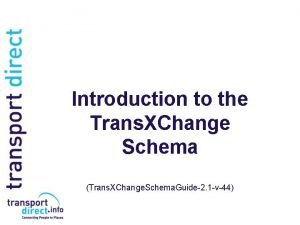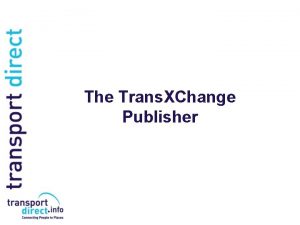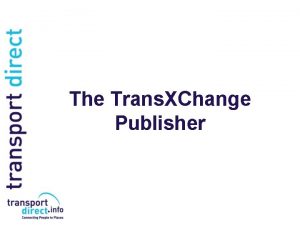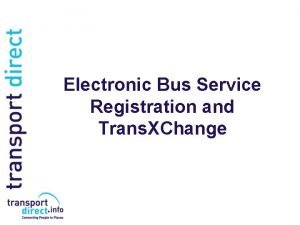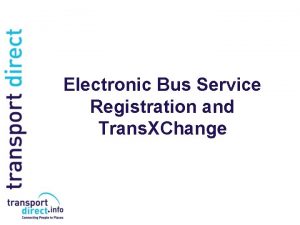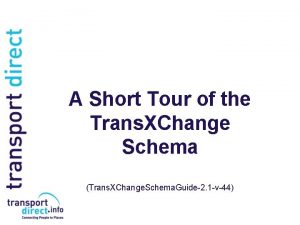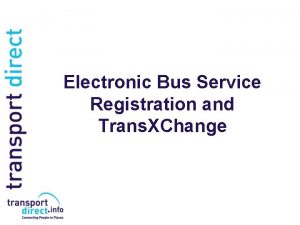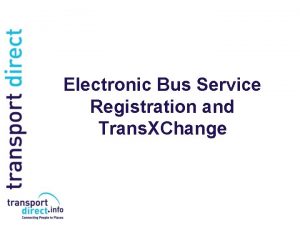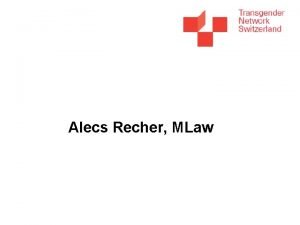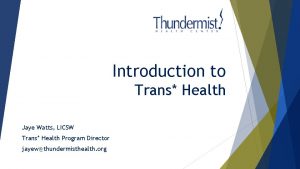Introduction to Trans XChange The Purpose of Trans

















- Slides: 17

Introduction to Trans. XChange

The Purpose of Trans. XChange n n Trans. XChange is a standard format for describing bus routes and schedules as XML documents that can be automatically exported and imported between different computer systems. There are two main variants of Trans. XChange: Registration schema: Defines XML documents specifically for the purpose of registering bus services with VOSA. Each document contains a single registered "service". General schema: Defines XML documents for exchanging bus timetables and related information for many different purposes. Many bus services can be specified in a single document. Partial schedules may be exchanged.

Trans. XChange Elements n n Trans. XChange comprises the following main elements: Trans. XChange Schema: A model and formal schema for describing and encoding bus schedules as XML documents. The schema can be used with software tools to check that documents are correctly formatted and contain the required content. Trans. XChange Documents and Process: A description and explanation of the standard, including rules for creating, managing and using Trans. XChange documents with software tools. Trans. XChange Publisher. The publisher is a free tool issued along with Trans. XChange, which allows users to render Trans. XChange XML documents into a readable timetable-like layout, using Acrobat pdf file format.

Document Validation n To be valid Trans. XChange data, documents must satisfy two levels of validity criteria: 1. Well-formedness and validity: Documents must parse and validate against the Trans. XChange schema at the specified level Registration or General including all the integrity constraints coded within the schema, such as for key uniqueness and reference. 2. Correctness: Documents must satisfy additional processing rules and constraints that are not enforceable in the XML of the schema, but which are specified in the Trans. XChange Schema. The publisher provides a diagnostic function to checks for a number of these errors.

How is Trans. XChange Used? n n The following three scenarios give the most common uses for Trans. XChange: (i) To register a complete service. (ii) To update a registration. (iii) To exchange service related data for a wide variety of other purposes.

(1) Registration of a Route with VOSA n n The most common scenario for use of Trans. XChange is to make a registration and runs as follows: 1. Bus schedule data is prepared using scheduling software, including route and stop data. 2. The schedule is exported as a Trans. XChange XML document to VOSA for registration. On export, the document is validated against a specified version of the schema. 3. The schedule is then imported by VOSA and Local Transport Authorities. On import, the document is validated against the version of the schema indicated by the document.

(1) Registration of a Route with VOSA n n … 4. Following validation, the registered particulars alone are rendered as a readable pdf document using the Registration option of the Trans. XChange publisher. 5. The schedule is then imported by information system builders such as journey planners and AVL system implementers. 6. All or part of routes and schedules may be exchanged by system providers, annotated with additional operational data, over and above the registered particulars.






(2) Update of a Registration with VOSA n n Trans. XChange will also be commonly used to update an existing registration. 1. The schedule is updated by the owner using the schedule preparation system. 2. The schedule is reported as an XML registration document with updated data and modified change dates. Note that the whole schedule must be recreated; Trans. XChange does not currently formally support the exchange of deltas , that is, changes to just part of a route or timetable (though this is likely to be added in future). 3. The schedule is revalidated and imported by VOSA, and the changed parts are updated in the VOSA database. The validation and propagation process thereafter is as for registration.

(3) General Purpose Exchange of Data n n n Trans. XChange can also be used for the general purpose exchange of structured bus schedule data between any two information systems. Normally the Trans. XChange General schema will be used for this purpose, as it allows consistent subsets of data to be exchanged. Example uses might include: Exchanging schedule information with journey planning systems that wish to use the service. Exchanging route information with mapping systems that wish to draw the route. Exchanging schedule and operational data with AVL systems that wish to provide real-time bus predictions. Exchanging school term dates with Educational Authorities. Exchanging Operator details.

Differences between the Schemas n n The Trans. XChange Registration and General schema are essentially the same, but differ in a few constraints as to cardinality and the required use of certain elements (see Trans. XChange Schema, Table 2 -1). As a general principle, the Registration schema is strictly substitutable with the General schema, that is, a valid Registration document will always validate against both schemas and can be used wherever a General document is used.

Related Transport Information Standards n n Trans. XChange is an XML based standard and is compatible with the following standards for public transport information: ATCO-CIF is a general purpose exchange format for common elements of timetable information. Trans. XChange is intended to be a successor to ATCO-CIF. Na. PTAN: The National Public Transport Access Nodes database is a UK nationwide system for uniquely identifying all the points of access to public transport in the UK. Na. PTAN is intended to assign every UK train station, coach terminus, airport, ferry terminal, bus stop, etc, a unique Na. PTAN identifier. NPTG: The National Public Transport Gazetteer is an auxiliary database to Na. PTAN that provides a means of relating Na. PTAN stops to UK towns and villages, as well as to the regional groupings used to manage Public Transport data.

Related Transport Information Standards n n Transmodel: Transmodel is an abstract Reference Data model of the data of interest to organisations designing transport related information systems. It has been developed through several European Commission sponsored projects. Journey. Web: Journey. Web is an XML protocol allowing distributed journey planning. The protocol is being used in the Transport Direct Portal project to provide contiguous distributed journey planning across the whole of the UK. SIRI: Service Interface for Real-time Information is a standard for the exchange of real time bus information between systems developed by CEN members of the UK Real Time Interest Group. It is also based on Na. PTAN and Transmodel. UK Geocoding References: For geospatial location references Trans. XChange supports both Grid references using Eastings and Northings, with support for both UK Mainland Irish grids and WGS 84 Latitude and Longitude. However Grid location references must be used for registrations.
